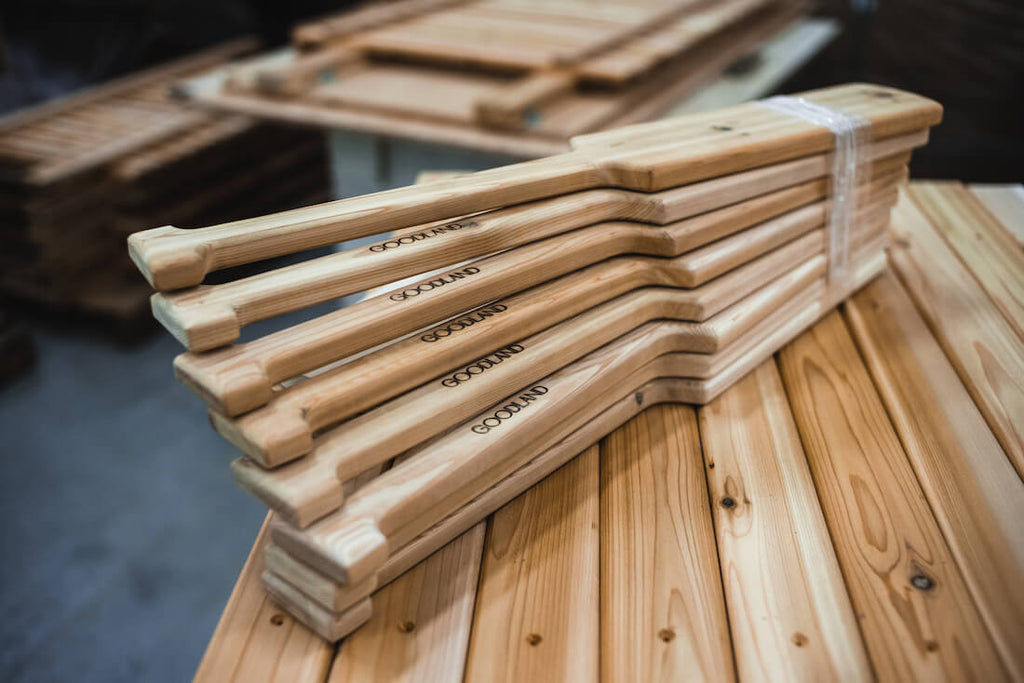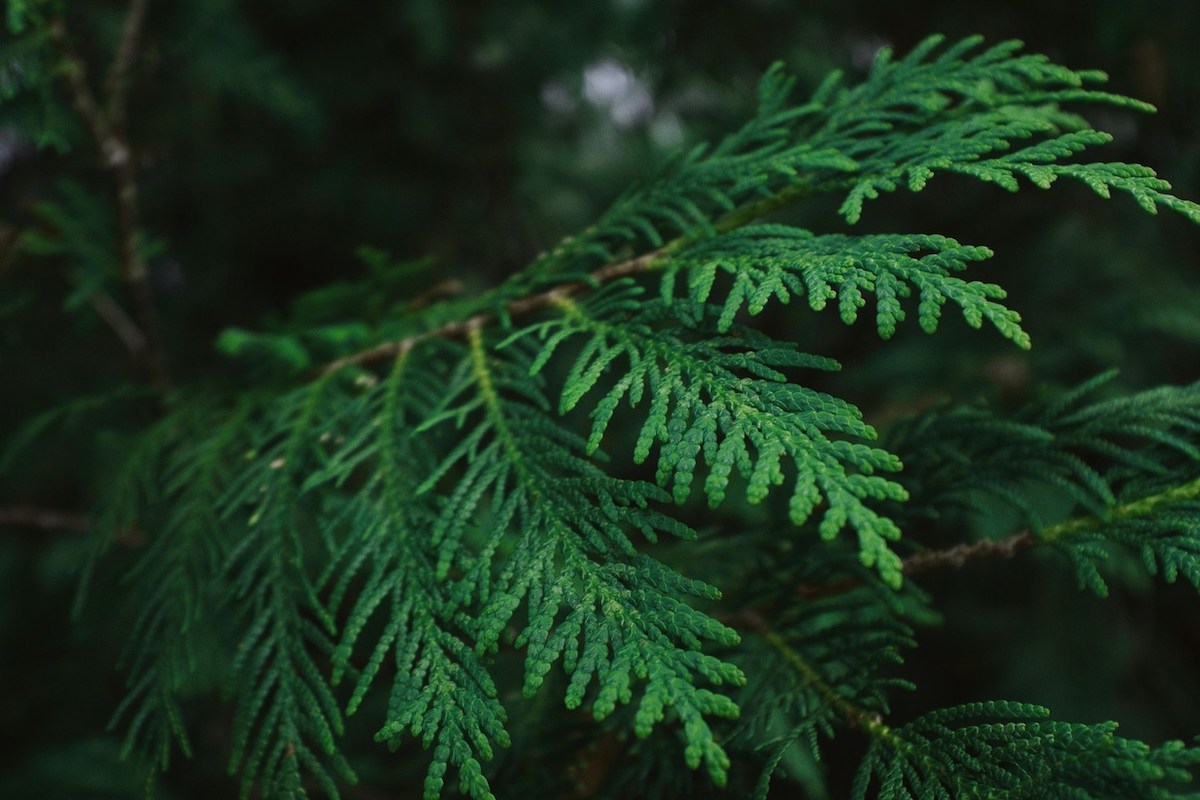Nestled among ancient evergreens and dappled sunlight, there is an iconic tree that captivates the senses and provides numerous benefits—western red cedar. This tree stands not only for its practical uses, but as an enduring symbol of cultural history.
Also known as Western redcedar, Pacific red cedar, giant cedar, and arborvitae, western red cedar (Thuja plicata) is a majestic evergreen tree that graces the cool, mild, and usually moist Pacific Northwest landscape. It thrives in mixed conifer forests often alongside Douglas fir, western hemlock, and spruce.
At GOODLAND we love to utilize this beautiful, durable wood in our designs for the many benefits outlined below. Western red cedar is also a sustainable, local material for us here in Western Canada. Our Wood Burning Hot Tub cladding, removable recliners, and paddle are constructed of raw red cedar, as are the Hot Tub Steps and Cedar Bath Tray.

Western red cedar on the Olympic Peninsula, Washington state circa 1925 // Image credit: PEMCO Webster & Stevens Collection, Museum of History & Industry, Seattle
How to Identify Western Red Cedar
The western red cedar tree’s presence is both commanding and delicate, with towering trunks widening at the base and drooping branches that sweep the forest floor. These trees may grow up to 60 m tall and 6 m wide (196 ft x 20 ft), and can live close to 1,000 years old. Unique identifiable features include its stringy, fibrous bark, and scale-like leaves in pairs that fold over each other like a flattened braid (the Latin ‘plicata’ means plait).
As the official tree of British Columbia—where GOODLAND is based—western red cedar possesses an abundance of characteristics that make it highly sought after, particularly in the worlds of design and building. Its touch reveals a smooth, supple texture while its grain describes a story of resilience.

Wood Colour & Grain
Western red cedar timber has a beautifully distinctive appearance featuring a reddish to pinkish-brown hue. The prominent straight grain patterns vary, possibly including delicate streaks of salmon pink, burgundy, copper, and/or umber.
When raw or untreated, red cedar differs greatly from the uniform and flat-looking yellow cedar. Typically straight-grained in pale yellow colours, yellow cedar is often stained to help it look more like its more popular cousin. If left untreated, over time both red and yellow cedars weather to an attractive silvery-gray patina.
Aroma
Prized for its natural fragrance, western red cedar’s aroma is described as pleasantly sweet, citrusy, and slightly spicy. And while humans may be drawn to it, insects and pests are not, making the wood particularly beneficial for exterior applications like structures, cladding, and decking, among many others.

Benefits of Red Cedar
Besides its aesthetic properties, western red cedar is highly valued for a stack of benefits that make it a versatile, sustainable choice for a wide range of applications.
Tannins
Tannins are a group of polyphenolic compounds found in many plant species including western red cedar. These compounds serve several purposes in plants, and their presence can be beneficial. The tannins in red cedar not only influence the colour of the wood, but also offer natural preservative properties which help protect the wood against insect infestation and decay. Tannins also make the wood less prone to chemical reactions and degradation, helping to maintain its structural integrity over time. In this context, western red cedar is well known for its weather resistance—withstanding exposure to sunlight, rain, and snow without rotting.
Durability & Longevity
The preservative properties of the natural compounds (tannins) as well as oils present in western red cedar enhance its longevity. The wood’s tight grain structure additionally contributes to its strength. This structural feature helps red cedar withstand various stresses and contributes to its overall durability.
Low Moisture Absorption
The natural oils present in cedar also repel water. The wood’s low moisture absorption rate means it is less prone to swelling, warping, and cracking compared to other types of wood. This quality enhances its resilience, especially with constant exposure to the elements, making it an excellent material for siding, decks, steps, fencing, and shingles.

Image credits: Photo by Brandon Shigeta and design by Dan Brunn, courtesy of Real Cedar
Stability
Western red cedar has low shrinkage, low density, and is more dimensionally stable than other conifers. This means the wood retains its shape and is less prone to warping, maintaining the structural integrity and appearance of structures.
Thermal & Insulating Properties
Because of its low density featuring plenty of air space, red cedar wood has excellent insulation properties. This makes it a really good choice for outdoor siding and roofing, helping regulate temperature and energy efficiency.
Lightweight & Easy to Work With
Relatively lightweight compared to other softwoods, western red cedar is easier to work with and install. In addition to being easy to cut and shape, this wood species has high appeal in the building industry for its workability and versatility, allowing for precise construction and stunning designs.

What is Cedar Used For?
Reading through all the benefits above, you’ve learned that western red cedar is used for a broad range of outdoor construction applications such as cladding, decking, stairs, shingles, fencing, outdoor furniture, and structures.
If you’ve ever researched wood fired hot tub materials, you’ve likely seen western red cedar featured in most North American designs. However, it should be known that cedar doesn’t do so well when in constant contact with water because the wood needs to swell in order to retain water. While the traditional cedar barrel hot tub designs look beautiful, they come with issues like shrinkage, leaks, and unexpected maintenance (especially when low-grade cedar is used). Additionally unless a water sanitization system is used and managed properly, the wood surface inside the cedar hot tub becomes slimy with a buildup of bacteria and microorganisms.
Some potentially surprising uses of western red cedar include:
- Acoustic guitar construction
- Cooking surface for grilling
- Smoking meat or fish while barbecuing
- Moth repellent in closets
- Skin care products
Besides its aromatic and insect-repelling properties, the essential oil extracted from western red cedar has several therapeutic attributes such as being an anti-inflammatory, antiseptic, and moisturizer.

Coast Salish canoe in Puget Sound // Image credit: Wellcome Images by Wellcome Trust, UK
The Tree of Life
One of western red cedar’s alternate names, arborvitae, translates to “tree of life” in Latin—the name given to cedar by indigenous peoples. Cedar holds profound importance for indigenous communities in North America. For thousands of years, these communities have cherished this tree species, incorporating it into ceremonies and medicinal practices as well as producing dozens of everyday materials from the tree.
Besides the wood itself, almost every part of the tree is used, including the bark, roots, and smaller pliable branches. The wood is a versatile resource utilized for architecture, furniture, transportation, art, tools, and ceremonial objects, while the fibrous bark has been woven into clothing, mats, baskets, nets, and rope.
Beyond its practical applications, cedar also carries immense spiritual significance for indigenous peoples. In some First Nations, sacred cedar might be burned during prayers, or to expel negative energies. Cedar boughs may be waved to purify homes and spread across sweat lodge floors. It also has a role in cleansing cold plunge baths.
Long before the concept of forest sustainability entered our collective consciousness, indigenous communities would use harvesting methods that ensured the survival of the tree as a species. For example, they might harvest planks from a standing tree instead of felling it, and carefully de-bark portions of a young tree to ensure its survival.

Sustainability
Today western red cedar is recognized for its sustainability, stemming from both its natural growth characteristics and contemporary responsible forestry practices in British Columbia. The tree has a remarkable ability to regenerate, with new seedlings often emerging in the presence of mature trees. This natural regeneration process contributes to the resilience of red cedar ecosystems.
Forestry management practices to enhance its sustainability include responsible harvesting techniques like selective cutting, ensuring that only a portion of the mature trees is harvested, while leaving others to continue the natural regeneration process. This approach maintains the ecological balance and biodiversity of the forest.
Harvested cedar trees have been diligently replaced by lumber producers in the last few decades so that North American forests have actually grown by 20% (source). Many forestry operations value, and adhere to, certification standards such as the Forest Stewardship Council (FSC), ensuring that this species is sourced in an environmentally and socially responsible manner.

Dive Deeper into Cedar
True or False?
Western red and Alaskan yellow cedar are called ‘false’ cedars because they’re actually in the cypress tree family (Cupressaceae), not the cedar (Cedrus). They were given the common name ‘cedar’ because of their similar appearance and aroma to the ‘true’ cedars: Atlas cedar, Cyprian cedar, cedar of Lebanon, and deodar or Himalayan cedar.
There are many different types of false cedar around the world. In North America we have:
- Eastern red cedar
- Western red cedar (what GOODLAND uses in our designs)
- Alaska yellow cedar, AKA Nootka cedar
- Atlantic white cedar, AKA southern white cedar, AKA swamp cedar
- Northern white cedar
- Port Orford cedar
- Incense cedar
- Japanese cedar (Sugi)
- Siberian cedar
Is Cedar a Hardwood or Softwood?
Because of its durability and use in construction, cedar is often mistaken to be a hardwood. As a coniferous tree it’s actually a softwood, but it sits on the dense end of the softwood spectrum.
Cedar as Firewood
When burned, red cedar has a relaxing and slightly spicy scent. These aromatic qualities along with the ability to ignite quickly and repel insects, make it an appealing firewood choice—but in reality it’s best used only for kindling. Cedar tends to burn relatively quickly with a lower heat value, which means it’ll provide a shorter-lasting fire with less heat compared to denser hardwoods like oak. If you do decide to use cedar as firewood, it's recommended to mix it with other hardwoods to balance its characteristics.
Charred Cedar
Using fire to char the surface of cedar is a technique employed to further weatherproof and preserve the wood before using it as siding, fencing, and other exterior purposes. Originating in Japan, these beautifully artful charred planks are known as yakisugi or “burned Japanese cedar” in English.
GOODLAND has more projects utilizing western red cedar in progress. If you’re curious, join our newsletter or watch our socials for reveals.



